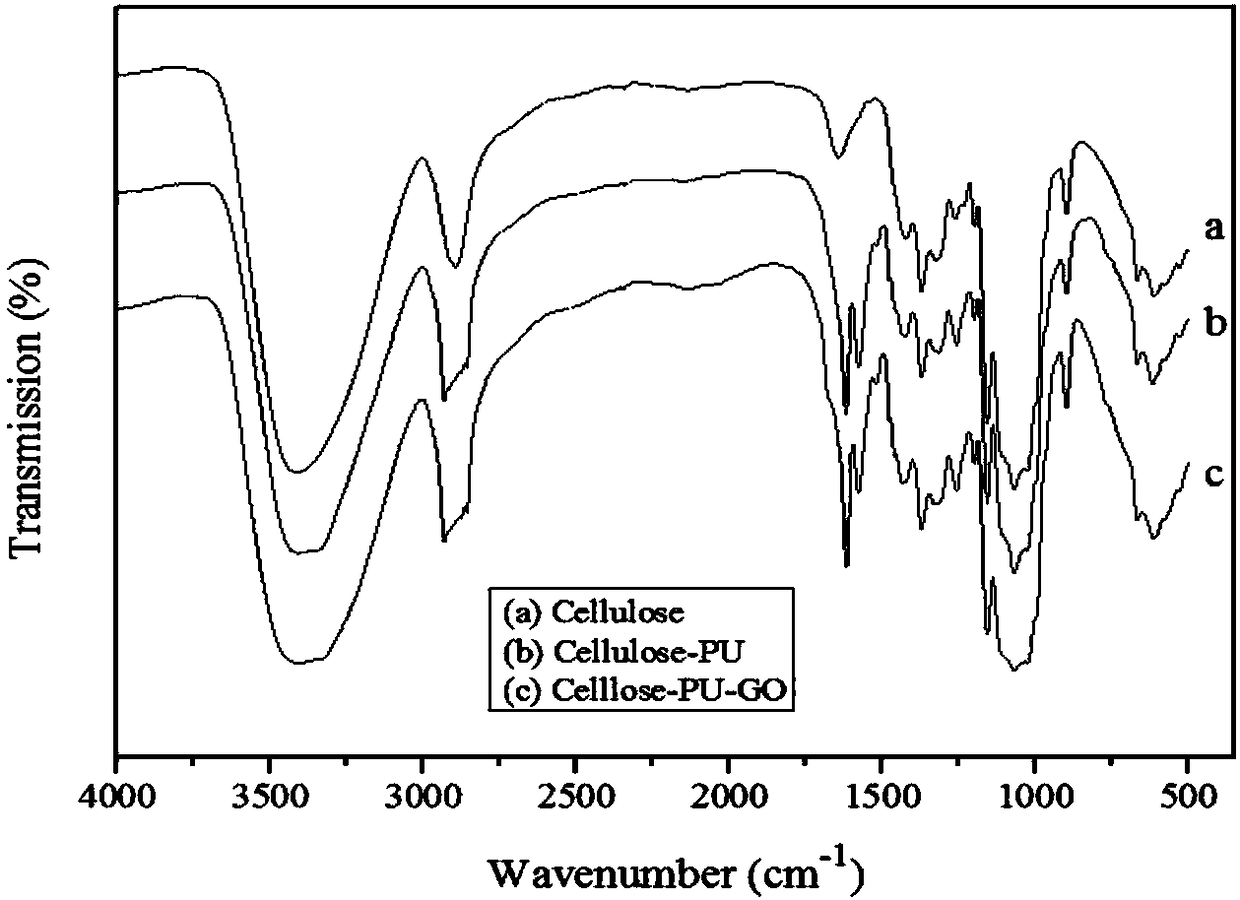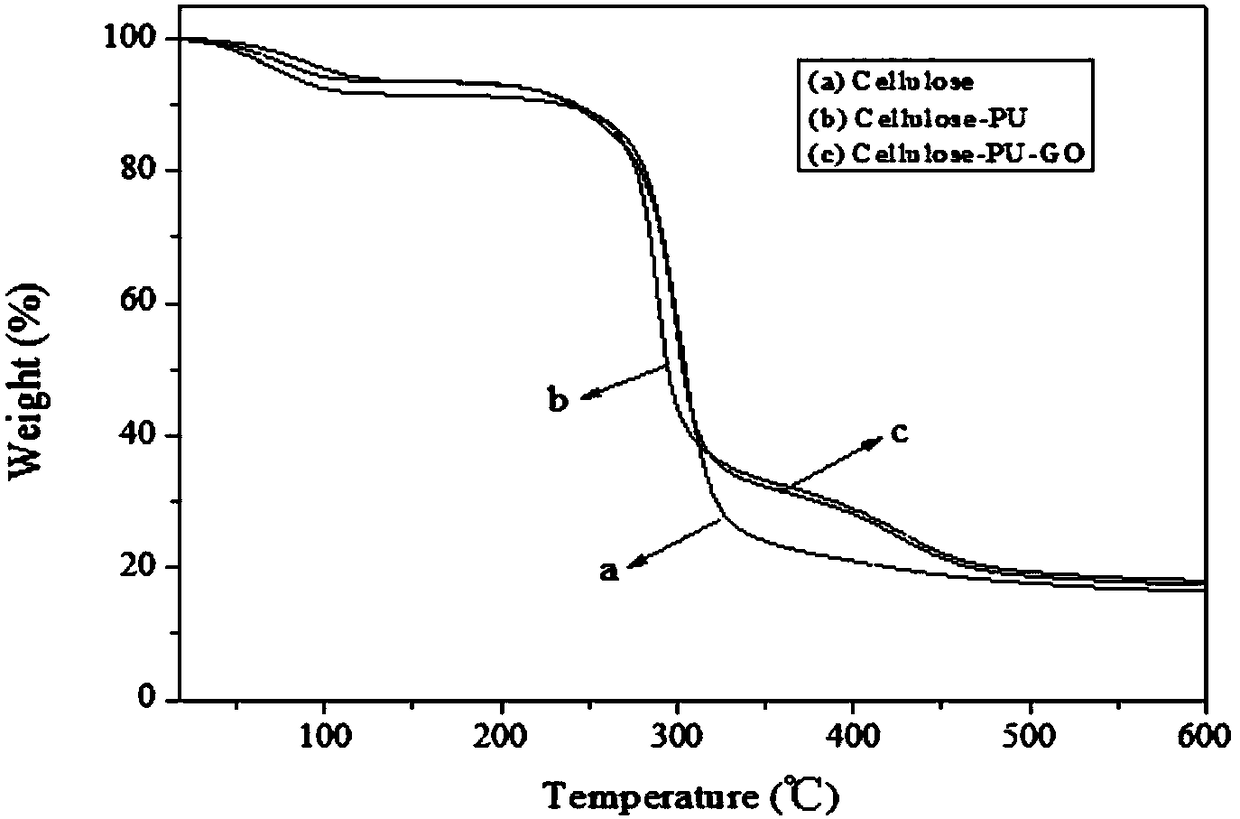Graphene oxide-modified polyurethane-cellulose battery separator and preparation method thereof
A lithium battery diaphragm and cellulose technology, which is applied in the field of graphene oxide modified polyurethane-cellulose lithium battery diaphragm and its preparation, can solve the problems of poor mechanical properties, high moisture permeability and limited application of cellulose film, and achieve convenient operation , comprehensive performance improvement, and easy-to-obtain effect
- Summary
- Abstract
- Description
- Claims
- Application Information
AI Technical Summary
Problems solved by technology
Method used
Image
Examples
Embodiment 1
[0028] Add 2.5g of fully dry cellulose into 40g of [Amim]Cl solution, stir in a 75°C water bath until completely dissolved. Under the protection of nitrogen, 0.6 g of 6-methylene diisocyanate was added to the cellulose casting solution and mixed evenly, and 0.03 g of dibutyltin dilaurate was added to react for 1.5 h. 0.02 g of graphene oxide was uniformly dispersed in 10 g of DMF solution by ultrasonic treatment for 25 min, and then the prepared graphene oxide suspension was added to the polyurethane-cellulose casting solution and mixed evenly. The mixed casting solution was left to defoam and then poured onto a clean glass plate, and scraped quickly with a scraper to form a film with a uniform thickness of 30 μm. The glass plate was immersed in distilled water to elute the solvent, and then the wet composite cellulose membrane was taken out, and the composite cellulose membrane was obtained after natural air drying.
Embodiment 2
[0030] Add 2.5g of fully dry cellulose into 40g of [Amim]Cl solution and stir in a water bath at 85°C until completely dissolved. Under the protection of nitrogen, 0.7 g of 6-methylene diisocyanate was added to the cellulose casting solution and mixed evenly, and 0.025 g of dibutyltin dilaurate was added to react for 1 h. 0.01 g of graphene oxide was uniformly dispersed in 10 g of DMF solution by ultrasonic treatment for 20 min, and then the prepared graphene oxide suspension was added to the polyurethane-cellulose casting solution and mixed evenly. The mixed casting solution was left to defoam and then poured onto a clean glass plate, and scraped quickly with a scraper to form a film with a uniform thickness of 28 μm. The glass plate was immersed in distilled water to elute the solvent, and then the wet composite cellulose membrane was taken out, and dried at 40° C. for 24 hours to obtain the composite cellulose membrane.
Embodiment 3
[0032] Add 2g of fully dry cellulose to 35g of [Amim]Cl solution, stir in a 75°C water bath until completely dissolved. Under the protection of nitrogen, 0.5 g of 6-methylene diisocyanate was added to the cellulose casting solution and mixed evenly, and 0.03 g of dibutyltin dilaurate was added to react for 1 h. 0.02 g of graphene oxide was uniformly dispersed in 15 g of DMF solution by ultrasonic treatment for 20 min, and then the prepared graphene oxide suspension was added to the polyurethane-cellulose casting solution and mixed evenly. The mixed casting solution was left to defoam and then poured onto a clean glass plate, and scraped quickly with a scraper to form a film with a uniform thickness of 40 μm. The wet composite cellulose membrane was taken out after the glass plate was immersed in distilled water to elute the solvent, and dried at 60° C. for 24 hours to obtain the composite cellulose membrane.
PUM
| Property | Measurement | Unit |
|---|---|---|
| thickness | aaaaa | aaaaa |
| thermal resistance | aaaaa | aaaaa |
| porosity | aaaaa | aaaaa |
Abstract
Description
Claims
Application Information
 Login to View More
Login to View More - R&D
- Intellectual Property
- Life Sciences
- Materials
- Tech Scout
- Unparalleled Data Quality
- Higher Quality Content
- 60% Fewer Hallucinations
Browse by: Latest US Patents, China's latest patents, Technical Efficacy Thesaurus, Application Domain, Technology Topic, Popular Technical Reports.
© 2025 PatSnap. All rights reserved.Legal|Privacy policy|Modern Slavery Act Transparency Statement|Sitemap|About US| Contact US: help@patsnap.com



